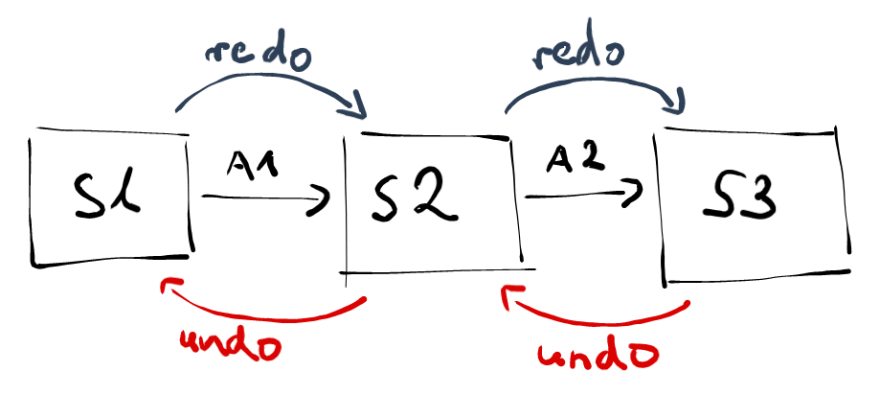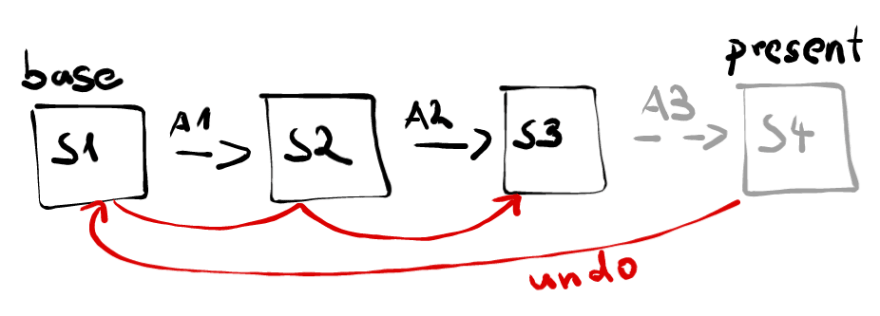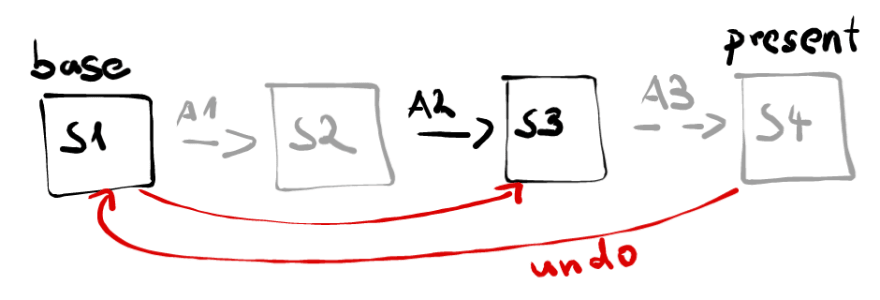Originally published at nils-mehlhorn.de on June 20, 2019
Having the ability to undo your actions has long moved from being an attractive product quality towards a must-be one. People just expect this type of fault tolerance from any reasonably complex tool. Yet, as often in software development, growing user expectations can be surprisingly far from ease of their fulfillment. In this post we'll be looking at how you might go about pulling off undo-redo in your next Angular app.
At its core, the general undo-redo feature can be described as the ability to go back to previous application states, and once there, in turn, go forward to then future states. Sounds easy right? It's so inherit to most people's workflow that you take it for granted. Yet, when its your turn to put the logic behind Ctrl+Z and Ctrl+Y you might be in for a surprise: there isn't - and there probably can't be - a pluggable solution if you didn't plan ahead.
Talking about application state in web applications the Redux pattern quickly comes to mind. Redux provides a good foundation through its three principles:
1. Single source of truth: By having the whole application state in one place - the store - we can get a good grip on past, present and future states.
2. State is read-only: We don't have to worry about states being corrupted.
3. Changes are made with pure functions: State is mutated in a deterministic way and we can easily replace the whole state.
You'll quickly end up at Redux - and it's Angular counterpart NgRx - when searching for ways to enable undo-redo in your app. It's a good way to plan ahead, yet, as we're about to see, it may not fulfill all your needs out-of-the-box.
In order to have a pluggable solution, undo-redo is probably best
implemented as a middleware or meta-reducer respectively for Redux or NgRx. So lets have a look at three different approaches for doing just that.
Switching states
For a working undo-redo feature we want to restore past and futures states. With NgRx and Redux, the straightforward solution seems to be the memorization of what has been in the application's store. The data structure for this approach could look like this:
interface History {
past: Array<State>
present: State
future: Array<State>
}
The feature would be implemented analogous to what we want to achieve. We'd continuously save states to the past stack upon user interaction and replace the present upon dispatch of an undo action. When this happens we save the present state to the future stack in order to apply it again upon dispatch of a redo action. Our middleware or meta-reducer could handle undo and redo actions as follows:
const undoRedo = (reducer) => {
let history = {
past: [],
present: initialState,
future: []
}
return (state, action) => {
switch (action.type) {
case 'UNDO':
// use first past state as next present ...
const previous = history.past[0]
// ... and remove from past
const newPast = history.past.slice(1)
history = {
past: newPast,
present: previous,
// push present into future for redo
future: [history.present, ...history.future]
}
return previous
case 'REDO':
// use first future state as next present ...
const next = history.future[0]
// ... and remove from future
const newFuture = history.future.slice(1)
history = {
// push present into past for undo
past: [history.present, ...history.past],
present: next,
future: newFuture
}
return next
default:
// derive next state
const newPresent = reducer(state, action)
history = {
// push previous present into past for undo
past: [history.present, ...history.past],
present: newPresent,
future: [] // clear future
}
return newPresent
}
}
}
The approach resembles the memento pattern - a common tool for implementing undo-redo. While it definitely works, it has certain flaws:
It can get big. You're basically multiplying your application's state. Depending on the scope you'd like to apply undo-redo to, this will eventually use up far more memory than actually necessary. Most of the times one transition will only change a rather small part of your state. Recording every single bit of state is just inefficient.
It's all or nothing. You can't limit undo-redo to certain actions. Suppose you start at state S1 and move to state S2 through an undoable user interaction. Next you move from state S2 to S3 through some action you don't want to be undoable. If you'd now go back to state S1 upon undo you'd lose the changes introduced in the transition from S2 to S3. You might overcome this issue through careful reducer composition which can be bit hard to achieve sometimes though.
Despite these trade-offs, the endorsed library for implementing undo-redo with the main Redux library is using this approach. There's nothing as big for NgRx yet some smaller ones are using the approach as well.
Repeating history
Reducers are just pure functions. Calculating the next state based on a dispatched action can be repeated deterministically at any time with the same result. Have a look at the illustration below. Action A1 changes our state S1 to S2. Equally, actions A2 and A3 transition to S3 and S4. Having saved the base state S1 and all intermediate actions, we'd be able to return to S3 when recalculating it by applying A1 and A2 to S1.
Therefore, in order to enable undo, we could also keep track of any dispatched action, replay them all except for the last one and we'd be one step into the past. Just looking at the undo part, a corresponding data structure could look like follows, where we'd push applied actions to a list and have a saved base state we'd use for recalculation.
interface History {
actions: Array<Action> // actions since base
base: State // base state representing the furthest point we can go back
}
Calculation of the last state could then look something like this:
const lastState = () => history.actions
.slice(0, -1) // every action except the last one
.reduce((state, action) => reducer(state, action), history.base)
Redux resembles the command pattern with it's actions serving as the commands. As a result, this approach to undo-redo acts as some kind of replay command pattern.
Again, the approach works and there are libraries for Redux and NgRx, respectively. It can even be more lightweight as actions are generally less heavy than your whole application state. Yet, depending on your reducer logic, it may be expensive to recalculate the state recursively from the start just to know where you were one second ago. But in contrast to the first approach, we can keep certain actions during recalculation to effectively prevent them from being undone - it doesn't have to be all or nothing anymore. If action A2 from our example should be kept from being undone, we'd keep it during recalculation and thus only skip A1.
However, implementing all of this can get messy and we've only just covered one direction. While it's definitely possible to use the recalculation approach for implementing both undo and redo, it'll get a bit too complex for my taste. That's also probably one reason why I couldn't find a library for NgRx doing it.
States are changing
Although actions in redux may resemble commands, for a common undo-redo implementation using the command pattern we'd also need their inverse: a way back, a return path for each state transition. Luckily, there's an easier way than implementing something like reverse reducers to improve our approach. States in Redux or NgRx may be supposed to be immutable, yet reducers are effectively changing them over time - just not by reusing the same object. You can keep track of these changes in a so-called JSON Patch:
// initial state
const S1 = { "foo": "bar" }
// JSON Patch representing what reducer did to change the state
const patch = [
{ "op": "add", "path": "/baz", "value": "qux" }
]
// result state when applying patch to S1
const S2 = { "foo": "bar", "baz": "qux" }
It gets even better: there are libraries constructing these patches for you and chances are you're already using one of them - namely immer. The library is used widely to ensure state immutability while being able to use otherwise mutating JavaScript APIs. Not only will immer create patches from your transitions, it'll also provide you with the corresponding inverse patches. Staying with the example above you'd easily be able to undo an action using the inverse patch from the corresponding state transition:
// result state from before
const S2 = { "foo": "bar", "baz": "qux" }
// JSON Patch representing the reverse of what reducer did to change the state
const inversePatch = [
{ "op": "remove", "path": "/baz" }
]
// resulting initial state when applying inversePatch to S2
const S1 = { "foo": "bar" }
Based on that we could then construct our history out of these patches:
interface Patches {
patches: Patch[]
inversePatches: Patch[]
}
interface History {
undone: Patches[]
undoable: Patches[]
}
The corresponding middleware or meta-reducer could look along the following lines - under the assumption that the underlying reducer will forward the required patches produced by immer.
import { applyPatches } from 'immer'
const undoRedo = (reducer) => {
let history = {
undone: [],
undoable: []
}
return (state, action) => {
switch (action.type) {
case 'UNDO':
// patches from last action
const lastPatches = history.undoable[0]
// push patches over so they can be used for redo
history = {
undone: [lastPatches, ...history.undone],
undoable: history.undoable.slice(1),
}
// derive state before last action by applying inverse patches
return applyPatches(state, lastPatches.inversePatches)
case 'REDO':
// patches from last undone action
const nextPatches = history.undone[0]
// push patches over so they can be used for undo
history = {
undoable: [nextPatches, ...history.undoable],
undone: history.undone.slice(1)
}
// derive state before undo (or after original action) by applying patches
return applyPatches(state, nextPatches.patches)
default:
return reducer(state, action, (patches, inversePatches) => {
// record patches through reducer callback
history = {
undoable: [
{patches, inversePatches},
...history.undoable
],
undone: [] // clear redo stack
}
})
}
}
}
Using this approach you're sparred from the memory overhead you'd have when remembering whole application states and also from the computational one you'd have when recalculating the last state. By using just the essential information your implementation can be maximally lightweight. And just like with the approach before, it doesn't have to be all or nothing. If you want to omit an action from the undo-redo feature you can just ignore its patches when undoing or redoing.
Bottom line
I hope I was able to give you some understanding of how undo-redo can work in applications using NgRx or Redux. As mentioned, any approach will basically get you there - just with different implications. Try them out by using a library or prototyping them yourself and see what works best for you.
In a recent use-case I found the patch-based approach to be working best for me, causing me to create the library ngrx-wieder for using it with NgRx. It'll also allow you to merge consecutive changes of actions and track whether you can undo or redo at the moment. Here's an example on StackBlitz:











Top comments (2)
I recently have attempted to implement an undo/redo feature for a Vue app I’m working on and it was tricky. There were a lot of things that needed to be taken into account.
It would be cool if I could turn that into a library. I only used 2 arrays(undoStack, redoStack) to store the temporary data. It worked without too many problems, but I’m really glad I found another approach here.
I’ll take the time to explore further this article, but first I’ll make sure I’m comfortable with Ngrx( I find it pretty overwhelming, though useful).
Thanks for sharing!
Are you using Vuex for that? The concepts should probably transfer, though I don't have much experience with Vue. NgRx won't fit into your Vue app or are you planning to convert it to Angular?
Anyway, hit me up on Twitter if you need any help! Maybe we can work something out like ngrx-wieder for Vuex :)